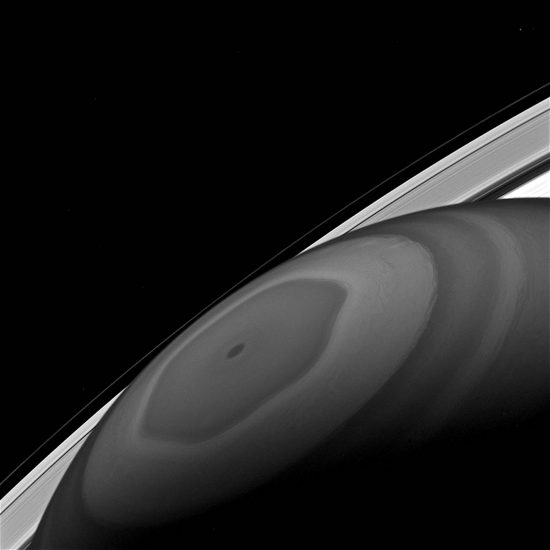
Dec 3, 2019
Hot spots on the gas giant planets are really very cold.
NASA scientists have been puzzled by Saturn’s hot north pole, although the term “hot” is relative. The average temperature at the pole is around minus 200 Celsius. The northern latitudes of Saturn were hidden from the Sun for many years, but the temperatures are equivalent to those radiated from the south pole.
Cassini’s infrared spectrometer data suggested that the south polar hot spot was connected to southern, sunlit conditions, prompting mission specialists to conclude that the Sun caused the south polar warming. However, since the north pole was dark since winter in 1995, that theory does not hold up; no sunlight was available to create a northern hot spot.
Cassini mission specialists speculate that the infrared signature from Saturn’s north pole is caused by convection currents carrying heat from the south. Planetary scientists conclude that air is “…compressed and heated up as it descends over the poles into the depths of Saturn.” However, they admit that the forces behind the atmospheric mixing, as well as Saturn’s global atmospheric motion, “still need to be understood.”
Previous Pictures of the Day argue that the mechanical view of the anomalies in the north fails to explain the increased temperature there. Since it is hotter than can be explained by the dim sunlight that it received prior to the vernal equinox, physicist Wal Thornhill suggested that another source for the energy input must be considered and that is electricity.
One of the most bizarre configurations discovered on Saturn is the hexagon that dominates its north pole. The formation was originally seen by cameras onboard the twin Voyager spacecraft that flew by Saturn in November 1980 and then again in August 1981. NASA researchers continue to refer to the structure as “unexplained”, since the convective interpretations of Saturnian weather do not include mechanisms by which clouds can organize themselves into polygonal shapes.
The hexagon at Saturn’s north pole is another example of electrical activity in the Solar System on a tremendous scale. Electricity moves along charged Birkeland current filaments that connect the Sun with its family of planetary bodies. The current energy flows most strongly into the giant gas planets because their charge differential with the Sun is greater than that of their smaller, rocky cousins.
The “electric Sun” is what drives the energetic meteorological phenomena on Saturn (and the other planets). Electrical circuits power the Sun and initiate the “anomalous heating” found on Saturn, as well as on the other gas planets that have been examined – Jupiter and Neptune display “hot poles” just like Saturn.
Once conventional science sees the question in electrical terms, the many puzzles with which they are confronted will become clear. Such issues as climate change on Earth and the double-eye vortices on Venus will be illuminated. Theories regarding the hot poles on Enceladus, Titan and Io will also benefit from acknowledging the principal tenets of the Electric Universe.
Stephen Smith
With apologies to Mick Billingham and Roger Charlery.
The Thunderbolts Picture of the Day is generously supported by the Mainwaring Archive Foundation.












